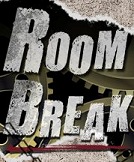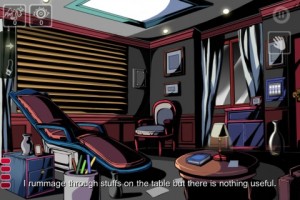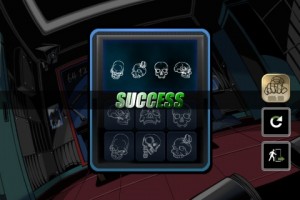 Another Kind of Breakout
Another Kind of Breakout
If you’ve always wondered what would happen if the Find the Hidden Object and logic puzzle genres were tossed into a blender with Twilight Zone: The Movie, look no further than Gameday’s App Store debut. It’s unfortunate that the translation ranges from hyper-excited to downright robotic, because this is yet another product of the Korean storyteller’s love of multiple scenarios. There’s the guy whose wife has a bizarre habit of locking him inside their house when she leaves; the murder suspect undergoing interrogation inside a hypnosis treatment facility; the scientist who gets sealed inside the Statue of Liberty while investigating a UFO that’s decided to perch on top of it; and the new Louvre curator who finds herself – you guessed it! – locked in with the world’s greatest art treasures for an evening. The one thing they all have in common is their goal — to stage a RoomBreak (Out Now for $0.99; Lite)!
 Each scenario contains five rooms the player must escape. Naturally the key, pass code, or other revelation needed to break out is the final product of a tireless search for items that must be used, combined, or broken down as circumstances require. RoomBreak’s mixture of item hunts, minigames and brain-busting logic puzzles don’t represent much that’s new to the keen-eyed casual adventure fan by now, but its formula does stand out in one important respect. In a typical Find the Hidden Object game, the player gets to tap anywhere, and any number of times, as a last resort when push comes to shove. RoomBreak, by contrast, rations all the player’s actions. Tapping frantically at the screen to force out that last helpful object whittles down a stamina meter; when that’s depleted it’s Game Over, and the player will have to re-start the current room from the top! The downside of this is that some puzzling logic went into the room solutions, requiring all that stamina-depleting guesswork and making the player’s first few attempts essentially sacrificial.
Each scenario contains five rooms the player must escape. Naturally the key, pass code, or other revelation needed to break out is the final product of a tireless search for items that must be used, combined, or broken down as circumstances require. RoomBreak’s mixture of item hunts, minigames and brain-busting logic puzzles don’t represent much that’s new to the keen-eyed casual adventure fan by now, but its formula does stand out in one important respect. In a typical Find the Hidden Object game, the player gets to tap anywhere, and any number of times, as a last resort when push comes to shove. RoomBreak, by contrast, rations all the player’s actions. Tapping frantically at the screen to force out that last helpful object whittles down a stamina meter; when that’s depleted it’s Game Over, and the player will have to re-start the current room from the top! The downside of this is that some puzzling logic went into the room solutions, requiring all that stamina-depleting guesswork and making the player’s first few attempts essentially sacrificial.
Adding further to the difficulty curve is the fact that the player starts off with one auto-solving hint for each type of situation he or she will encounter: important object locations while in search mode, the proper use of items while digging through inventory, and solutions for logic puzzles or minigames. Once those are used up, it’s In-App Purchase time for the desperate player! I had the impression that there’s some feature for redeeming these hints with Game Center achievement points – which would be a rockin’ way of tying achievements to gameplay – but the instructions for doing so are much less clear than simply ponying up the cash. Regardless of how you feel about IAPs in principle, RoomBreak’s design defeats the concept. Why splurge on an IAP to get past a logic puzzle when you’ll only find yourself stumped by it again after the inevitable Game Over?
 Thankfully, RoomBreak’s logic puzzles are quite satisfying to conquer manually in the first place, and represent the game’s greatest strength. RoomBreak presents every imaginable and unimaginable variant of logic puzzle, ranging from symbol interpretation, to math puzzles, to picture alignment — and the best examples incorporate all three. That said, you’ll want to steer clear of RoomBreak if you’re looking for games that you can whip out at a moment’s notice on the subway; this is one you’ll want to keep a pencil and paper on hand for, because diagrams and plenty of forehead-slapping will come into play. Absent a full official walkthrough, players would do well to keep the developer’s Facebook page and support link handy.
Thankfully, RoomBreak’s logic puzzles are quite satisfying to conquer manually in the first place, and represent the game’s greatest strength. RoomBreak presents every imaginable and unimaginable variant of logic puzzle, ranging from symbol interpretation, to math puzzles, to picture alignment — and the best examples incorporate all three. That said, you’ll want to steer clear of RoomBreak if you’re looking for games that you can whip out at a moment’s notice on the subway; this is one you’ll want to keep a pencil and paper on hand for, because diagrams and plenty of forehead-slapping will come into play. Absent a full official walkthrough, players would do well to keep the developer’s Facebook page and support link handy.
Speaking of references for when you get stuck, I must make RoomBreak’s tutorial my greatest complaint. It can be skipped, but it’s incredibly important to go through because it introduces the player to RoomBreak’s interface and various minigames that come into play during the five scenarios. Considering the quality of the English translation and the number of target languages the developer’s trying to tackle with this one, it’s easy to understand why they employed static pictorial instructions followed by practice sessions for each concept. If my experience is any indication, some players will suffer no end of frustration as they try to figure out the sledge hammer and knife-wielding minigames for the first time, because they’re fairly complex and the player doesn’t have access to the instructions and the practice sessions at the same time — these are presented sequentially. I wasn’t even aware that the pictorials spanned multiple slide panels until I saw a walkthrough of the tutorial on Touchgameplay. For best enjoyment, add that to your list of essential links before diving into this one!
 As far as the genre goes on iOS, RoomBreak’s interface is about on par — a little clunky, but it becomes second nature once you get used to it. A right-hand, tap-operated side bar lets the player switch between object handling, inspection, walking, and item usage while exploring. The left-hand inventory menu is swiped open, and a drag-and-drop interface is used to mix or decompose items stored within. It would be worth the developer’s time to take another look at the touch sensitivity of the left-hand menu’s swipe tab; it seems the player has to hit it just right to close out the menu, and that’s indicative of a touch sensitivity area that’s a little too small for the object’s size.
As far as the genre goes on iOS, RoomBreak’s interface is about on par — a little clunky, but it becomes second nature once you get used to it. A right-hand, tap-operated side bar lets the player switch between object handling, inspection, walking, and item usage while exploring. The left-hand inventory menu is swiped open, and a drag-and-drop interface is used to mix or decompose items stored within. It would be worth the developer’s time to take another look at the touch sensitivity of the left-hand menu’s swipe tab; it seems the player has to hit it just right to close out the menu, and that’s indicative of a touch sensitivity area that’s a little too small for the object’s size.
There’s no questioning Gameday’s talent in the art department, and this goes a long way toward pulling the player in despite RoomBreak’s weak translation. A collection of compelling, atmospheric tunes also await the player who sticks with RoomBreak past the first few escapes. Each scenario can be counted on for an hour of head-scratching gameplay on average, and this leaves RoomBreak very well stocked with content. Mature themes abound, so this isn’t necessarily one to pass off to the little’uns.
iFanzine Verdict: A most unbalanced offering in the App Store’s library of Find the Hidden Object/casual adventure/logic puzzle mashups. On the one hand, RoomBreak sports addictive and well-designed puzzles, and enjoys high production values for the price range; on the other hand, weak translation, a potentially off-putting approach to challenge, and murky tutorials hold it back. If you’re a fan of the specified genres, give the Lite a go first and see if the whole package is likely to meet your tastes.
[xrr rating=3/5]

